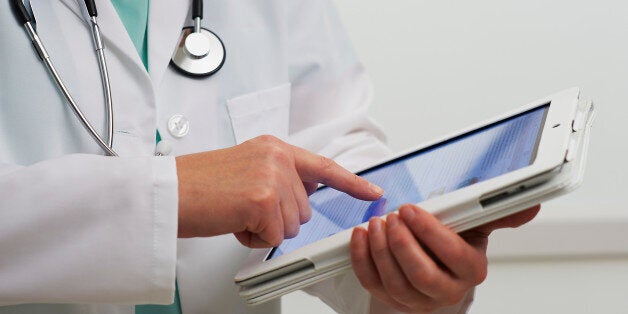
Just imagine if the only tablet you needed was a smart tablet. Can our iPads, Galaxies and Xperias keep us well so that we never have to reach into the drugs cabinet? As the interface between people wherever they happen to be and a digitally joined-up, super-slick healthcare system, this idea promises to shift the paradigm away from treating illness in hospitals to maintaining wellness at home. But it's all wishful thinking without a properly surveyed route map.
There's no doubting the allure of this vision. No more inconvenient time off for simple medical consultations; you can facetime through your tablet. Chronically ill loved ones' vital signs can be remotely monitored to give early warnings of deterioration. Your child's medication app can interface with their teacher's, protecting them from being given the wrong dose at school. Most basic of all, no need to give your name, age and history to every new healthcare worker you encounter along the care pathway. Combined with genomics, personalised medicine and companion diagnostics, enabled by technology, we are far more empowered to look after ourselves than ever before.
The digital device is a powerful tool for providers and administrators too. With it as the interface to big data analytics, we can wave goodbye to traditional intuitive practice and hello to dashboards displaying accurate real world diagnostic aids. Time and resources can be freed up as expert systems take over specialist work, allowing jobs to be reassigned safely to more abundant, less highly qualified people. Error and unnecessary testing can be reduced which, apart from saving lives, can significantly reduce the cost burden for public health.
All the while, autonomous sensors and algorithms can monitor public health and help control epidemics faster than ever before. But to harness the true potential we need digital bit owners to relinquish their privacy in matters of life and death for the greater good. It is in the hands of individuals to open the door to better population health, research and create advances in preventative health and treatment. So what and why are we hiding?
With the cost of healthcare outstripping economic growth and the impact of chronic diseases alone set to balloon to $47 trillion in the next 20 years according to the World Economic Forum (WEF), health leaders and policy makers are at a tipping point.
We have a once-in-a-generation chance to capitalise on the digital paradigm's potential to do more with less. In immature healthcare systems around the world, the prize is even greater: a golden opportunity to leapfrog the present to be ready for the future.
The impact of all this on how we plan future healthcare facilities could be profound. In planning new infrastructure, the longer we extrapolate from the past without accounting for the digitally disrupted future, the higher the risk of building white elephants that will be a burden to future generations.
Predictions all see health systems focused on keeping people well in their homes, supported by wearable, ingestible and ambient monitors. They see more and more care being provided outside hospital walls. No doubt there will always be a place for hospitals but their shape and their role will change. So, should we be master planning our hospitals to shrink rather than grow? Should we in fact build wellness centres, not hospitals (as a recent SEA report recommends)? Will we need to convert our hospitals to research centres? How big do ourdata centres and ICT infrastructures that support the digitisation of health need to be? How will the flow of patients change through the emerging care pathways? Will we still need waiting rooms? Should we be building hospitals that can convert to call centres? At the very least, we should be leveraging the power of computing to understand and optimise these options. Should specialist healthcare infrastructure be needed, it must be adaptable.
The future is here. Progress in digital is under way, but fragmented, with investors popping whatever entrepreneurial pill happens to be available from the headshop. As the WEF says, businesses see the rewards but are grappling with the risks, unable to see the implications of changes to customer expectations, cultural norms, and regulation. It is not yet translating to fundamental changes to health services and infrastructure. What's holding them back is the lack of an overarching strategy.
To say the route to smart tablet wellness is tricky is an understatement. We need integrated thinking and fresh perspectives.
These challenges need to be addressed by industry and government leaders to unlock the substantial potential digital offers to society. A spoonful of integrated strategy will make the obstacles come down, and guide us safely to our smart tablet future.